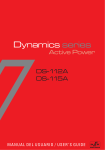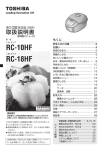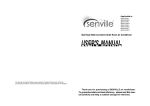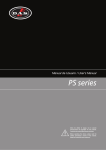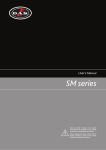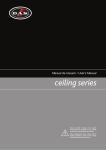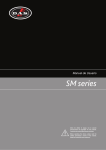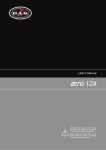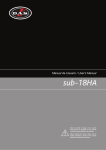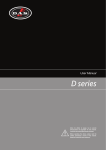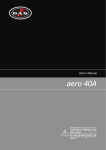Download D.A.S. sub-18HA User`s manual
Transcript
User’s Manual DR active series Antes de utilizar el equipo, lea la sección “Precauciones de seguridad” de este manual. Conserve este manual para futuras consultas. Before operating the device, please read the “Safety precautions” section of this manual. Retain this manual for future reference. DR active DR active series Precauciones de Seguridad Safety Precautions Cajas acústicas activas / Self-powered loudspeaker enclosures El signo de exclamación dentro de un triángulo indica la existencia de importantes instrucciones de operación y mantenimiento en la documentación que acompaña al producto. Conserve y lea todas estas instrucciones. Siga las advertencias. The exclamation point inside an equilateral triangle is intend to alert the users to the presence of important operating and maintenance (servicing) instructions in the literature accompanying the product. Heed all warnings. Follow all instructions. Keep these instructions. Equipo de Clase I. Class I device. El signo del rayo con la punta de flecha, alerta contra la presencia de voltajes peligrosos no aislados. Para reducir el riesgo de choque eléctrico, no retire la cubierta. The lightning and arrowhead symbol warns about the presence of uninsulated dangerous voltage. To reduce the risk of electric shock, do not remove the cover. La posición de encendido está indicada en el interruptor mediante los correspondientes símbolos normalizados (IEC 60417-1:1998 y IEC 60417-2:1998). The ON position is indicated in the switch by means of the corresponding standardized symbols (IEC 60417-1:1998 and IEC 60417-2:1998). No exponga este equipo a la lluvia o humedad. No use este aparato cerca del agua (piscinas y fuentes, por ejemplo). No exponga el equipo a salpicaduras ni coloque sobre él objetos que contengan líquidos, tales como vasos y botellas. Equipo IP20. Do not expose this device to rain or moisture. Do not use this apparatus near water (for example, swimming pools and fountains). Do not place any objects containing liquids, such as bottles or glasses, on the top of the unit. Do not splash liquids on the unit. IP-20 equipment. Este símbolo indica que el presente producto no puede ser tratado como residuo doméstico normal, sino que debe entregarse en el correspondiente punto de recogida de equipos eléctricos y electrónicos. This symbol on the product indicates that this product should not be treated as household waste. Instead it shall be handed over to the appicable collection point for the recycling of electrical and electronic equipment. Equipo diseñado para funcionar entre 15ºC y 35ºC con una humedad relativa máxima del 75%, con un rango de ±10% de la tensión nominal de alimentación indicada en la etiqueta trasera (según IEC 60065:2001). Working temperature ranges from 15ºC to 35ºC with a relative humidity of 75%, with ±10% of the rated main voltage value indicated on the rear label (according to IEC 60065:2001). El cableado exterior conectado al equipo requiere de su instalación por una persona instruida o el uso de cables flexibles ya preparados. The outer wiring connected to the device requires installation by an instructed person or the use of a flexible cable already prepared. Si el aparato es conectado permanentemente, la instalación eléctrica del edificio debe incorporar un interruptor multipolar con separación de contacto de al menos 3mm en cada polo. If the apparatus is connected permanently, the electrical system of the building must incorporate a multipolar switch with a separation of contact of at least 3mm in each pole. Desconecte este aparato durante tormentas eléctricas, terremotos o cuando no se vaya a emplear durante largos periodos. Unplug this apparatus during ligtning storms, earthquakes or when unused for long periods of time. No emplace altavoces en proximidad a equipos sensibles a campos magnéticos, tales como monitores de televisión o material magnético de almacenamiento de datos. Do not place loudspeakers in proximity to devices sensitive to magnetic fields such as television monitors or data storage magnetic material. Para las cajas con vaso para trípode, la altura máxima de seguridad desde el suelo a la base de la caja montada sobre trípode modelo TRD-2 con pies a su máxima extensión es: For enclosures with tripod socket, maximum safety height from floor to bottom of enclosure when mounting on a TRD-2 tripod with legs fully open: DR-108A ----------------------->150 cm DR-112A ----------------------->140 cm DR-15A,DR-115A -------------->130 cm DR-108A ------------------------>150 cm DR-112A ------------------------>140 cm DR-15A,DR-115A --------------->130 cm No existen partes ajustables por el usuario en el interior de este equipo. Cualquier operación de mantenimiento o reparación debe ser realizada por personal cualificado. Es necesario el servicio técnico cuando el equipo se haya dañado de alguna forma, como que haya caído líquido o algún objeto en el interior del aparato, haya sido expuesto a lluvia o humedad, no funcione correctamente, haya recibido un golpe o su cable de red esté dañado. No user serviceable parts inside. Refer all servicing to qualified service personnel. Servicing is required when the apparatus has been damaged in any way, such as power-supply cord or plug is damaged, liquid has been spilled or objects have fallen into the apparatus, the apparatus has been exposed to rain or moisture, does not operate normally or has been dropped. Limpie con un paño seco. No use limpiadores con disolventes. Clean only with a dry cloth. Do not use any solvent based cleaners. No instale el aparato cerca de ninguna fuente de calor como radiadores, estufas u otros aparatos que produzcan calor. Debe instalarse siempre sin bloquear la libre circulación de aire por las aletas del radiador. Do not install near any heat sources such as radiators, heat registers, stoves or other apparatus that produce heat. The circulation of air through the heatsink must not be blocked. Manual del Usuario / DR active / User’s Manual GARANTÍA Todos nuestros productos están garantizados por un periodo de 24 meses desde la fecha de compra. Las garantías sólo serán válidas si son por un defecto de fabricación y en ningún caso por un uso incorrecto del producto. Las reparaciones en garantía pueden ser realizadas, exclusivamente, por el fabricante o el servicio de asistencia técnica autorizado. Otros cargos como portes y seguros, son a cargo del comprador en todos los casos. Para solicitar reparación en garantía es imprescindible que el producto no haya sido previamente manipulado e incluir una fotocopia de la factura de compra. WARRANTY All D.A.S. products are warrantied against any manufacturing defect for a period of 2 years from date of purchase. The warranty excludes damage from incorrect use of the product. All warranty repairs must be exclusively undertaken by the factory or any of its authorised service centers. To claim a warranty repair, do not open or intend to repair the product. Return the damaged unit, at shippers risk and freight prepaid, to the nearest service center with a copy of the purchase invoice. Manual del Usuario / DR active / User’s Manual DECLARACIÓN DE CONFORMIDAD DECLARATION OF CONFORMITY D.A.S. Audio, S.A. C/ Islas Baleares, 24 - 46988 - Pol. Fuente del Jarro - Valencia. España (Spain). Declara que la serie DR active: Declares that DR active series: Cumple con los objetivos esenciales de las Directivas: Abide by essential objectives relating Directives: l Directiva de Baja Tensión (Low Voltage Directive) 2006/95/CE l Directiva de Compatibilidad Electromagnética (EMC) 2004/108/CE l Directiva RoHS 2002/95/CE l Directiva RAEE (WEEE) 2002/96/CE Y es conforme a las siguientes Normas Armonizadas Europeas: In accordance with Harmonized European Norms: l EN 60065:2002 l EN 55103-1:1996 Electromagnetic compatibility. Product family standard for audio, video, audiovisual and entertainment lighting control apparatus for professional use. Part 1:Emission. l EN 55103-2:1996 Electromagnetic compatibility. Product family standard for audio, video, audiovisual and entertainment lighting control apparatus for professional use. Part 2:Immunity. Audio, video and similar electronic apparatus. Safety requirements. Manual del Usuario / DR active / User’s Manual Manual del Usuario / DR active / User’s Manual CONTENTS 3 INTRODUCTION General information Features AMPLIFIER DESCRIPTION 4 Models: DR-15A and DR-108A Models: DR-112A and DR-115A 6 CONNECTIONS Signal wiring Full range connection Reinforcement with powered subwoofer Passive subwoofer reinforcement Loop thru 7 INSTALLATION Placement Tripod use Stage monitor use Mounting to walls and ceilings. Hanging 8 USE Switch ON/OFF Limiter indicators (Limit) Equalisation Overheating Low mains voltage 9 TROUBLESHOOTING BLOCK DIAGRAMS 10 LINE DRAWINGS 11 SPECIFICATIONS 11 APPENDIX 12 Line connections: unbalanced and balanced Manual del Usuario / DR active / User’s Manual EN EN Manual del Usuario / DR active / User’s Manual INTRODUCTION General information Amplifier features (Models: DR-15A DR-15AW and DR-108A) Thank you for purchasing D.A.S. Audio S.A. products. The DR series represents more than 30 years of expertise in transducer and enclosure design, achieving a system that utilises the most advanced sound reinforcement technology to deliver outstanding audio performance and maximum reliability. This manual contains the required information to make the best use of the system you have purchased. Please take the time to read it. Our Web site at www.dasaudio.com contains further support information such as enclosure and system drawings, data for modelling software, architectural specifications and specification sheets. ? DMAT (Discrete Monolithic Amplifier Technology) 150W amplifier for the low frequencies and 50W for the high frequencies. ? Active limiter system. ? Linkwitz-Riley crossovers for greater vocal clarity. ? Plug & play self-powered systems. ? Power, signal presence and overload indicator lights (LEDs) let you know what is going on. ? Built-in 2-channel mixer with line and microphone inputs allows all-in-one operation for the most compact applications. ? Balanced line output for daisy-chaining as many units as needed. General features DR-15A / DR-15AW ! 15” woofer. ! High frequency compression driver with 1.34” coil. ! Medium power. ! Medium sensitivity. ! Medium throw. ! Hanging points (M8): 2 upper, 2 lower and 4 rear. ! Optional mounting accessory. ! Optional “W” version. ! ! ! ! ! ! ! Amplifier features (Models: DR-112A and DR-115A) ? State of the Art amplifier technology including class-D high efficiency low weight amplifiers. ? Plug & play self-powered systems. ? XLR (Cannon) balanced input. ? XLR (Cannon) parallel output. ? Line and microphone use. ? 300W amplifier for lower frequencies and 100W for upper frequencies. DR-108A 8”woofer. High frequency compression driver with 1” coil. Medium / low power. Medium sensitivity. Medium throw. Hanging points (M8): 3 lower. Optional mounting accessory. DR-112A ! 12”woofer. ! High frequency compression driver with 1.34” EN coil. ! Medium power. ! Medium sensitivity. ! Medium throw. ! Hanging points (M8): 3 upper and 2 lower. ! Optional mounting accessory. DR-115A ! 15”woofer. ! High frequency compression driver with 1.34” coil. ! Medium power. ! Medium sensitivity. ! Medium throw. ! Hanging points (M8): 3 upper and 2 lower. ! Optional mounting accessory. Manual del Usuario / DR active / User’s Manual 3 AMPLIFIER DESCRIPTION B) MIC: Controls the level for the MIC (microphone) input. C) LEVEL: Controls the system's main level, acting on the microphone and line mix. D) LINE OUT : This 1/4” (6.35 mm) line output is used to send the built-in mixer output signal. As many units as required can be daisy-chained. It can also be used to feed a power amplifier. It is located before the main LEVEL control, and thus this control can be used as the level control for each system within a group of daisy-chained systems.This balanced connector has three pins for which pin assignments are as follows : Sleeve = GND (Ground). Tip = (+) non-inverted signal. Ring = (-) inverted signal. K) Power-on indicator red led (at the front of the box). A B C LINE MIN G H E E) LINE INPUT : 1/4” (6.35 mm) and XLR (Cannon) combo line input. Plug in line sources such as mixers, keyboards, CD players, audiocassette or video players. This input has two sets of three pins for which pin assignments are as follows: 1 or Sleeve=GND (Masa). 2 or Tip=(+) non-inverted signal. 3 or Ring=(-) inverted signal. MIC MIN LEVEL MIN SIGNAL OVERLOAD LINE INPUT MIC GAIN LINE OUT MIC D F I ® ELECTRONICS 2 3 1 HOT COLD GND HOT COLD o A) LINE : Controls the level for the LINE input. J) AC INPUT : Standard IEC male connector, fuse holder and power switch. Plug the unit mains cable here. Replace fuse on the fuse holder with a same type fuse, if the fuse is blown. Power switch (with standard symbols): Turns the unit on = ’|’ Turns the unit off = ‘O’ BALANCED INPUTS AND OUTPUTS DR-15A and DR-108A amplifier GND Spain N1918 Made in 230V 50/60Hz 2A D.A.S. AUDIO S.A. (Valencia) SPAIN CAUTION: FOR CONTINUED PROTECTION AGAINST RISK OF FIRE REPLACE ONLY WITH THE SAME TYPE 2AL 250V FUSE WARNING: THIS PRODUCT MUST BE GROUNDED REFER TO USER MANUAL FOR CONNECTION NO USER SERVICEABLE PARTS INSIDE CAUTION RISK OF ELECTRIC SHOCK DO NOT OPEN J F) MIC : Microphone input via an XLR (Cannon) connector. Plug in any microphone that does not require phantom powering. This input has three pins for which pin assignments are as follows : 1 = GND (Ground). 2 = (+) non-inverted signal. 3 = (-) inverted signal. G) SIGNAL : Signal presence indicator led. Shows signal presence at the mixer output but before the main LEVEL control. Thus, it is dependent on the position of the microphone (MIC) and LINE controls. EN H) OVERLOAD : Clip indicator red led. Amplifier saturation (clip) indicator. I) MIC GAIN: Controls the input gain for the microphone input to accommodate different microphone sensitivities. Factory set to mid position. 4 Manual del Usuario / DR active / User’s Manual K K DR-112A and DR-115A amplifier A) MIC/LINE : Switches between microphone and line modes. The indicator light on the left hand side of the switch is lit when the microphone mode is activated. B) LOW CUT: Switches a 100 Hz high-pass filter on and off. C) LEVEL: Controls the level of the system. D) LOOP THRU : Used for paralleling several units, which will share the same input. This balanced connector has three pins for which pin assignments are as follows : 1 = GND (Ground). 2 = (+) non-inverted signal. 3 = (-) inverted signal. A B C E D H G I F E) LINE INPUT : Balanced signal XLR. Pin assignments as follows : 1 = GND (Ground). 2 = (+) Non-inverted signal. 3 = (-) Inverted signal. F) ON : Power-on indicator green led. G) SIGNAL : Signal presence indicator green led. H) LIMIT : Limiter indicator leds for each of the frequency bands, LF and HF. I) AC INPUT : Standard IEC male connector, fuse holder and power switch. Plug the unit mains cable here. Replace fuse on the fuse holder with a same type fuse, if the fuse is blown. Power switch (with standard symbols): Turns the unit on = ’|’ Turns the unit off = ‘O’ J EN J) Power-on indicator red led (at the front of the box). J Manual del Usuario / DR active / User’s Manual 5 CONNECTIONS Powered sub-woofer reinforcement connection Signal wiring There are two basic ways to transport an audio signal with microphone or line level: Unbalanced line: Utilising a two-conductor cable, it transports the signal as the voltage between them. Electro-magnetic interference can get added to the signal as undesired noise. Connectors that carry un-balanced signals have two pins, such as RCA (Phono) and 1/4” (6.35 mm, often referred to as jack) mono. 3-pin connector such as XLR (Cannon) may also carry un-balanced signals if one of the pins is unused. Balanced line: Utilising a three-conductor cable, one of them acts as a shield against electro-magnetic noise and is the ground conductor. The other two have the same voltage with respect to the ground conductor but with opposite signs. The noise that cannot be rejected by the shield affects both signal conductors in the same way. At the device's input the two signals get summed with opposite sign, so that noise is cancelled out while the programme signal doubles in level. Most professional audio devices use balanced inputs and outputs. Connectors that can carry balanced signal have three pins, such as XLR (Cannon) and 1/4” (6.35 mm) stereo. We recommend the use of balanced wiring with the DR active series. The illustrations on Appendix of this manual show the recommended connection with different types of connectors to balanced processor or amplifier inputs. The system can be used as a full range system, or with subwoofer reinforcement: To use it in combination with a self-powered subwoofer (such as the sub-18HA), plug the mixer into the subwoofer, and connect the satellite output to the DR-112A/115A. If you have more boxes per channel, simply daisy chain DR112A/115As and subwoofers as shown. P a s s i v e s u b - w o o f e r re i n f o rc e m e n t connection The system can be complemented by a passive subwoofer unit such as the sub-18HF. You will need a power amplifier and a two-way stereo electronic crossover unit, such as a DSP-26, crossing over at a frequency in the 100-160 Hz range. The graph shows an example of a connection using a passive (non-powered) subwoofer. Stand alone full-range use connection Simply plug the mixer output into the enclosure's input. If you have more than one box per channel, use the LOOP THRU output to link the signal from one box to the next as shown. Loop thru EN The LOOP THRU output is an output XLR in parallel with the input connector and is useful for daisy chaining the input signal to a number of boxes, connecting them in parallel. The number of units that can be linked this way depends on the output impedance of the equipment driving the enclosure, such as the mixer or processor. Typically, to avoid signal degradation, the maximum number that can be daisy chained is given by the formula (1250/Z), where Z is the output impedance of the equipment driving the enclosure. For instance, a 100 ohm output impedance allows daisy chaining 12 boxes. 6 Manual del Usuario / DR active / User’s Manual INSTALLATION Placement Place the speakers ahead of the microphones. Feedback (howling) occurs when the microphones pick up the sound that comes out of the speakers and feeds it back to the system. Feedback can cause damage to your unit. If space is limited, direct the speakers towards areas where there are no microphones to minimise feedback. When using a turntable, place the speakers far from the turntables. If the speaker signal is picked up by the stylus and re-amplified, low frequency howling will occur. The use of a very heavy base for the turntable is recommended. Note: The angle on the back of models DR112A and DR-115A allows for floor monitor use without extra accessories. The illustrations show box operation angles. Use on top of sub-18H/ sub-18HF The model sub-18H/sub-18HF is equipped with a built-in upper 35 mm socket (this is the standard tripod diameter). Then, with the TRD-4 accessory (optional), one DR active unit can be used on top of one sub-18H/sub-18HF unit. Do not use mounted systems on irregular floors or with slopes. TRD-4 TRD-2 Tripod use AX-12/ 15 AX-108 ANL-1 31 AX-115 68 0 Ø2 14 The unit is equipped with a built-in tripod socket for use with standard 35-mm tripods such as the TRD-2. The socket has a locking screw to fix the orientation of the box; make sure it is unscrewed enough before mounting the box onto the tripod, so that the screw is not in the way of the tripod and does not protrude from the tripod socket. Be careful not to raise the box too high on the tripod, as it may become unstable. Place the speakers as high as possible. For best results, try to place the high frequency unit above the audience's heads. If the loudspeakers are located too low, the listeners at the end of the room will not hear quality sound. M8 Mounting to walls and ceilings. Hanging EN Optional wall and/or ceiling mounting brackets are available for all full-range models. These are detailed on the “Specifications” section. Hanging hardware should be regularly inspected and suspect units replaced if in doubt. This is important to avoid injury and absolutely no risks should be taken on this respect. The units can only be flown individually, but up to three DR112A/115As can be flown vertically from one another. The ANL-1 set is a set of four eyebolts and four carabiners for flying that is available separately. The following illustration shows the detail of the ANL-1's components. Manual del Usuario / DR active / User’s Manual 7 USE Switch ON/OFF Overheating A sound system should be switched on sequentially. Switch on the self-powered unit last in your sound system. Switch on the sound sources such as CD players or turntables, then the mixer and finally the self-powered unit. If you have several units, it is recommended that you switch them on sequentially one at a time. Follow the inverse order when switching off, turning self-powered units off before any other element in the sound system. Mute all signal sources before switching the unit on or off. Limiter indicators (LIMIT) It is recommended that the red LIMIT LED indicators are not lit continuously; at most they should blink only occasionally. If you wish to have a visual indication at the mix position of whether the LIMIT LEDs are lighting, during equipment set-up, closely observe what mixer VUmeter level corresponds to the level that lights the enclosure's LIMIT LEDs. That level should not be exceeded during the event. Due to their high efficiency, the DR series amplifiers generate very little residual heat and therefore do not need a fan for cooling. In normal use, the amplifier panel will be warm to the touch. If the unit stops playing (or just the mid-high or the bass sections), the amplifier's overheating protection may be activated to protect the components from thermal damage. Overheating may be due to insufficient cooling, or to very aggressive use in extremely hot conditions. Do not use the unit in proximity to high power lights. Once the amplifier cools down, it switches back on automatically. If the unit should shut down again, try reducing the volume a notch to avoid overheating. Low mains voltage If mains voltage falls below the shutdown voltage for the unit, it will stop playing. When acceptable levels are regained, the unit will switch back on automatically. Equalisation The units do not need extreme settings of equalisation to produce quality sound. Avoid high levels of gain on the equalisers. Gain values above +6 dB on a console's EQ are not recommended. For speech applications the LOW CUT is recommended to filter out low frequency excess. It can also be useful if we need to drive the boxes at very high levels, relieving some of the excursion off the cone. AC = 230 V EN Current consumption (A) Max. Power 1/3 Power 1/8 Power Idle DR-15A & DR-108A 1,1 0,5 0,25 0,1 DR-112A & DR-115A 2,9 0,66 0,2 0,1 860 390 195 80 2270 515 155 80 Heat emission (BTU/h) Max. Power 1/3 Power 1/8 Power Idle 8 Manual del Usuario / DR active / User’s Manual TROUBLESHOOTING PROBLEM No sound from the unit. The power on LED indicator (on the front of the unit) does not light up when the power switch is at the on (“|”) position. CAUSE 1 - Bad or loose AC connection to the unit or the mains outlet. 2 - Faulty AC cable. 3 - Blown Fuse. No sound from the unit. The power on LED indicator (on the front of the unit) lights up when the power switch is at the on (“|”) position. 1 - The channel (MIC or LINE) or the main (LEVEL) volume controls are set too low. 2 - The signal source is sending no signal. 3 - Defective cable. Full power cannot be obtained. The OVERLOAD or LIMIT indicators never lights up. Feedback appears when the LEVEL is turned up. 1 - Check you connections. Insert the IEC plug securely into the unit's AC socket. 2 - Check the cables, connectors and AC power with a suitable mains tester. 3 - Replace fuse on fuse holder under AC input with a same fuse type only. If it blows again, take the unit to a service centre. 1 - Turn up the volume for the channel you are using (MIC or LINE) as well as the main LEVEL control. 2 - Check that the mixer or sound source is sending signal to the unit. 3 - Check that the cable from the sound source to the unit is connected correctly. Replace the cable if defective. 1 - The channel (MIC or LINE) or the main (LEVEL) volume controls are not at maximum. 2 - The signal source does not have a hot enough output. 1 - Turn the channel (MIC or LINE) or the main (LEVEL) volume controls up. 1 - The microphone is pointing towards the speakers. 2 - The microphone is not directional enough or the talker/performer is too far from the microphone. 1 - Place the speakers in front of the microphones. 2 - Use quality directional microphones such as cardioid, super-cardioid or hypercardioid and/or nicely ask the talker/performer to talk. 3 - Avoid high gain settings on the equaliser. 3 - Incorrect EQ. Sound is distorted, but LIMIT or OVERLOAD indicators do not light up. SOLUTION 1 – The mixer is distorting. 2 – The signal reaching the unit is too hot. 2 - If using a mixer, use the balanced output if available. Use a professional mixer with a hotter output, or use a preamplifier between the sound source and the unit. 1 - Turn the down the main out or the channel gains on the mixer. Check the signal source. 2 - Set the LEVEL control no lower than ten o'clock. Lower the main mixer output level. Sound is distorted and very loud. The OVERLOAD (or LIMIT) LED indicator lights up. 1 - The system is overloaded and has reached maximum power. 1 - Turn the mixer level down. The microphone can hardly be heard with the LEVEL control at maximum. 1 - The unit is not being used in microphone mode. 1 - Set the LEVEL control to 9 o'clock approximately and press the MIC/LINE button. Adjust the LEVEL control further to get the desired level. 2 - Adjust the MIC GAIN control further to get the desired level. When speaking into a microphone, voices are heavy. 1 - Microphone proximity effects. Bass gets dramatically louder when speaking too close to the microphone. 1 - Speak a little further away from the microphone. Press the LOW CUT button and /or turn down the low frequency equalisation if available. 2 - Turn the channel (MIC or LINE) or the main (LEVEL) volume controls down. 3 - If the LIMIT LED lights up, press the LOW CUT button. Manual del Usuario / DR active / User’s Manual EN 9 PROBLEM Hum or buzz when a mixer is connected to the unit. Hum or buzz when a CD, cassette, VCR or keyboard is connected to the unit. CAUSE 1 - The console probably has unbalanced outputs. You may be using an incorrect un-balanced to balanced cable. 1 – Read the Appendix A of this manual to make a correct un-balanced to balanced cable. 2 - The mixer and powered speaker are not plugged into the same mains outlet. 2 – Connect the mixer and the powered speaker to the same mains outlet. 3 - The audio signal cable is too long or too close to an AC cable. 3 – Use a cable that is as short as possible and/or move the audio signal cable away from mains cables. 1 - The equipment and powered speaker are not plugged into the same mains outlet. 1 - To determine if the hum is coming from the equipment connected to the powered speaker set the main LEVEL control to minimum and check if the hum goes away. If that is the case, connect the mixer and the powered speaker to the same mains outlet. 2 - The audio signal cable is too long or too close to an AC cable. 2 - Use a cable that is as short as possible and/or move the audio signal cable away from mains cables. 3 - Replace the mains cord with one that has a ground conductor. 3 - The mains cable has only two conductors and therefore has not a ground terminal and the chassis is not grounded adequately. 4 - The cable is defective and has an open shield. Hum or buzz when using lighting controls in the same building. 1 - The audio signal cable is too long or too close to the lighting cable. 2 - On a sound system with three-phase AC, the lighting equipment and the unit are connected to the same phase. BLOCK DIAGRAMS EN DR-108A and DR-15A amplifier DR-112A and DR-115A amplifier 10 SOLUTION Manual del Usuario / DR active / User’s Manual 4 - Replace the cable. 1 - Move the audio signal cable away from lighting cables. Try to find out at what point the noise is leaking into the system. 2 - Connect the sound system to a different phase than the lights. You may need the help of an electrician. 300 303 165 360 444 453 DR-108A DR-15A 690 LINE DRAWINGS ALL DIMENSIONS IN MILIMETERS ALL DIMENSIONS IN MILIMETERS 455 420 370 400 710 DR-115A DR-112A 615 147 ALL DIMENSIONS IN MILIMETERS ALL DIMENSIONS IN MILIMETERS SPECIFICATIONS MODEL Nominal LF Power Amplifier Nominal HF Power Amplifier Input Type Input Impedance Sensitivity DR-15A/DR-15AW DR-108A DR-112A DR-115A 150 W (AB) 150 W (AB) 300 W (D) 300 W (D) 50 W (AB) 50 W (AB) 100 W (AB) 100 W (AB) Balanced Differential Line Balanced Differential Line Balanced Differential Line Balanced Differential Line Line: 20 kohms; Mic: 2 kohms Line: 20 kohms; Mic: 2 kohms Line: 20 kohms Line: 20 kohms Line: 0.75 V (-0.28 dBu) Line: 0.75 V (-0.28 dBu) Line: 1.23 V (+4 dBu) Line: 1.23 V (+4 dBu) Mic: 3mV, 150mV (-48dBu, -14dBu) Mic: 3mV, 150mV (-48dBu, -14dBu) Frequency Range (-10 dB) Rated Maximum Peak SPL at 1 m(1) HF Horn Coverage Angles (-6 dB) Enclosure Material Finish/Color Transducers/Replacement Parts Connectors INPUT LOOP THRU MIC AC INPUT Dimensions(H x W x D) Weight Accessories Notes: (1). 45 Hz-20 kHz 60 Hz-18 kHz 50 Hz-20 kHz 45 Hz-20 kHz 127 dB 120 dB 128 dB 130 dB 90° H x 70° V 90° H x 45° V 90° H x 45° V 90° H x 45° V Polypropylene Polypropylene Polypropylene Polypropylene Black or White (W) Black Black Black LF: 15Mi/GM 15Mi LF: 8B/8B LF: 12Mi4/GM 12Mi4 LF: 15Mi4/GM 15Mi4 HF: M-34/GM M-34 HF: M-26/GM M-26 HF: M-34/GM M-34 HF: M-34/GM M-34 Female XLR-Jack Female XLR-Jack Female XLR Female XLR Jack Jack Male XLR Male XLR XLR XLR Male IEC Male IEC Male IEC Male IEC 70 x 45 x 36 cm 45 x 30 x 30 cm 62 x 40 x 37 cm 71 x 46 x 42 cm 28 x 18 x 15 in 18 x 12 x 12 in 24 x 16 x 14.5 in 28 x 18 x 16,5 in 23.4 kg (51.5Ib) 12.2 kg (26.8Ib) 19.7 kg (43.5Ib) 22.1 kg (48.5Ib) ANL-2 ANL-1 ANL-1 ANL-1 FUN-15 AX-M AX-115 AX-115 TRD-2 FUN-DS-108 TRD-2 FUN-DS-115 TRD-2 FUN-DS-112 TRD-2 EN Maximum calculated Peak SPL based on sensitivity and RMS amplifier power. Manual del Usuario / DR active / User’s Manual 11 APPENDIX: Line connections: unbalanced and balanced There are two basic ways to transport an audio signal with microphone or line level: Unbalanced line: Utilising a two conductor cable, it transports the signal as the voltage between them. Electromagnetic interference can get added to the signal as undesired noise. Connectors that carry unbalanced signals have two pins, such as RCA (Phono) and ¼” (6.35mm, often referred to as jack) mono. 3 pin connector such as XLR (Cannon) may also carry unbalanced signals if one of the pins is unused. Balanced line: Utilising a three conductor cable, one of them acts as a shield against electromagnetic noise and is the ground conductor. The other two have the same voltage with respect to the ground conductor but with opposite signs. The noise that cannot be rejected by the shield affects both signal conductors in the same way. At the device’s input the two signals get summed with opposite sign, so that noise is cancelled out while the programme signal doubles in level. Most professional audio devices use balanced inputs and outputs. Connectors that can carry balanced signal have three pins, such as XLR (Cannon) and ¼” (6.35mm) stereo. The graphs that follow show the recommended connection with different types of connectors to balanced processor or amplifier inputs. The connectors on the left-hand side come from a signal source, and the ones on the right hand side go to the inputs of the processor or amplifier. Note that on the unbalanced connectors on the left-hand side, two terminals are joined in side the connector. If hum occurs with balanced to balanced connections, try disconnecting the sleeve (ground) on the input connector. Note that the illustrations show what should be connected to what, but that pin locations on an actual XLR connector are different. Also, pin 2 hot is assumed on XLR connectors. EN 12 Manual del Usuario / DR active / User’s Manual D.A.S. AUDIO, S.A. C/. Islas Baleares, 24 46988 Fuente del Jarro Valencia, SPAIN Tel. 96 134 0525 Tel. Intl. +34 96 134 0860 Fax 96 134 0607 Fax Intl. +34 96 134 0607 D.A.S. AUDIO OF AMERICA, INC. Sunset Palmetto Park 6816 NW 77th Court. Miami, FL. 33166 - U.S.A. TOLL FREE: 1-888DAS4USA Tel. +1 305 436 0521 Fax +1 305 436 0528 UM_DRA_03_EN www.dasaudio.com D.A.S. AUDIO ASIA PTE. LTD. 25 Kaki Bukit Crescent #01-00/02-00 Kaki Bukit Techpark 1 Singapore 416256 Tel. +65 6742 0151 Fax +65 6742 0157






















